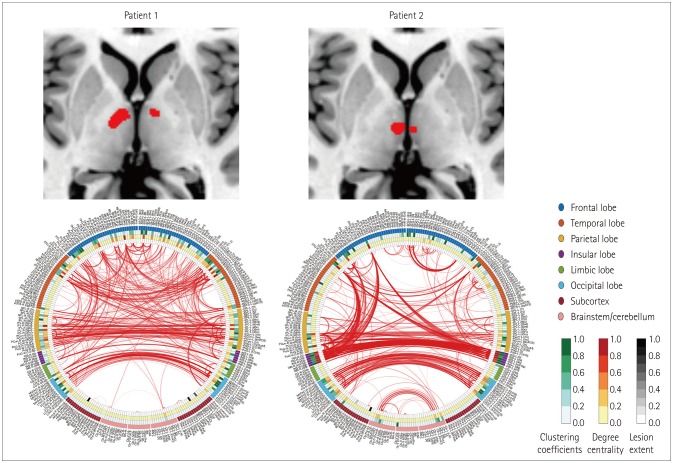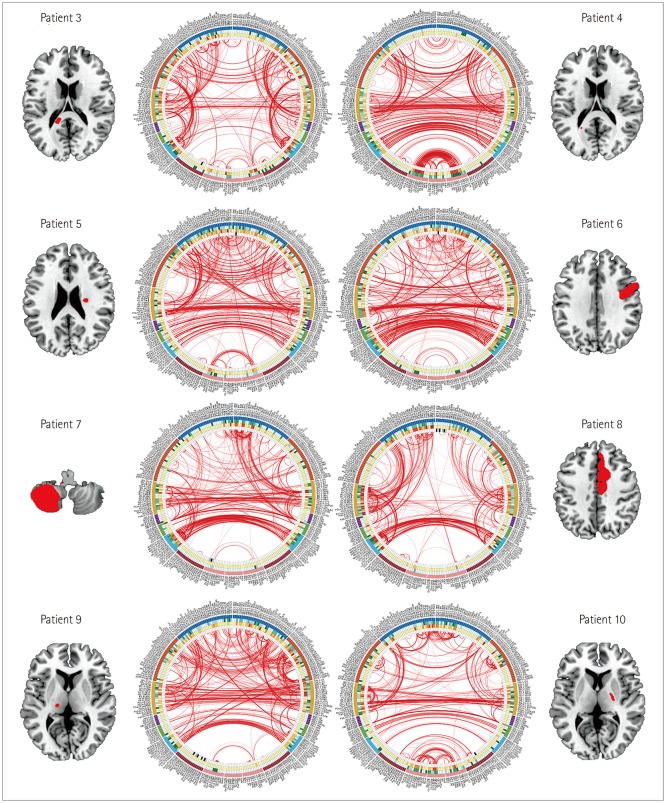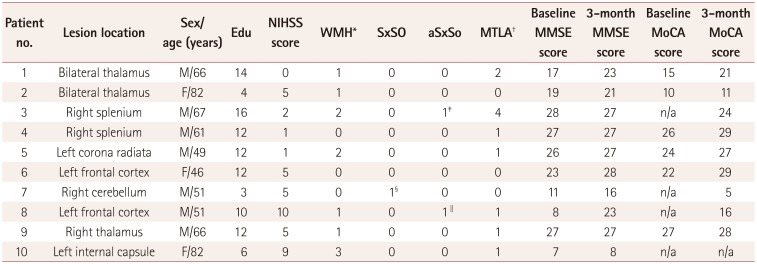1. Wernicke C. The symptom-complex of aphasia. In : Church A, editor. Disease of the nervous system. New York: Appleton;1908. p. 265–324.
2. Sporns O, Tononi G, Kötter R. The human connectome: a structural description of the human brain. PLoS Comput Biol. 2005; 1:e42. PMID:
16201007.

3. Fox MD. Mapping symptoms to brain networks with the human connectome. N Engl J Med. 2018; 379:2237–2245. PMID:
30575457.

4. Boes AD, Prasad S, Liu H, Liu Q, Pascual-Leone A, Caviness VS Jr, et al. Network localization of neurological symptoms from focal brain lesions. Brain. 2015; 138:3061–3075. PMID:
26264514.

5. Margulies DS, Böttger J, Watanabe A, Gorgolewski KJ. Visualizing the human connectome. Neuroimage. 2013; 80:445–461. PMID:
23660027.

6. Rorden C, Brett M. Stereotaxic display of brain lesions. Behav Neurol. 2000; 12:191–200. PMID:
11568431.

7. Ashburner J, Friston KJ. Unified segmentation. Neuroimage. 2005; 26:839–851. PMID:
15955494.

8. Friston KJ, Williams S, Howard R, Frackowiak RS, Turner R. Movement-related effects in fMRI time-series. Magn Reson Med. 1996; 35:346–355. PMID:
8699946.

9. Muschelli J, Nebel MB, Caffo BS, Barber AD, Pekar JJ, Mostofsky SH. Reduction of motion-related artifacts in resting state fMRI using aCompCor. Neuroimage. 2014; 96:22–35. PMID:
24657780.

10. Diedrichsen J, Maderwald S, Küper M, Thürling M, Rabe K, Gizewski ER, et al. Imaging the deep cerebellar nuclei: a probabilistic atlas and normalization procedure. Neuroimage. 2011; 54:1786–1794. PMID:
20965257.

11. Fan L, Li H, Zhuo J, Zhang Y, Wang J, Chen L, et al. The human brainnetome atlas: a new brain atlas based on connectional architecture. Cereb Cortex. 2016; 26:3508–3526. PMID:
27230218.

12. Rubinov M, Sporns O. Complex network measures of brain connectivity: uses and interpretations. Neuroimage. 2010; 52:1059–1069. PMID:
19819337.

13. Kim BJ, Park JM, Kang K, Lee SJ, Ko Y, Kim JG, et al. Case characteristics, hyperacute treatment, and outcome information from the clinical research center for stroke-fifth division registry in South Korea. J Stroke. 2015; 17:38–53. PMID:
25692106.

14. Lim JS, Noh M, Kim BJ, Han MK, Kim S, Jang MS, et al. A methodological perspective on the longitudinal cognitive change after stroke. Dement Geriatr Cogn Disord. 2017; 44:311–319. PMID:
29393166.

15. Scheltens P, Barkhof F, Leys D, Pruvo JP, Nauta JJ, Vermersch P, et al. A semiquantative rating scale for the assessment of signal hyperintensities on magnetic resonance imaging. J Neurol Sci. 1993; 114:7–12. PMID:
8433101.

16. Scheltens P, Leys D, Barkhof F, Huglo D, Weinstein HC, Vermersch P, et al. Atrophy of medial temporal lobes on MRI in “probable” Alzheimer's disease and normal ageing: diagnostic value and neuropsychological correlates. J Neurol Neurosurg Psychiatry. 1992; 55:967–972. PMID:
1431963.

17. Duering M, Righart R, Csanadi E, Jouvent E, Hervé D, Chabriat H, et al. Incident subcortical infarcts induce focal thinning in connected cortical regions. Neurology. 2012; 79:2025–2028. PMID:
23054230.

18. Lambert C, Simon H, Colman J, Barrick TR. Defining thalamic nuclei and topographic connectivity gradients in vivo. Neuroimage. 2017; 158:466–479. PMID:
27639355.

19. Reijmer YD, Freeze WM, Leemans A, Biessels GJ. Utrecht Vascular Cognitive Impairment Study Group. The effect of lacunar infarcts on white matter tract integrity. Stroke. 2013; 44:2019–2021. PMID:
23686971.

20. Heinen R, Vlegels N, De Bresser J, Leemans A, Biessels GJ, Reijmer YD. Utrecht Vascular Cognitive Impairment study group. The cumulative effect of small vessel disease lesions is reflected in structural brain networks of memory clinic patients. Neuroimage Clin. 2018; 19:963–969. PMID:
30003033.

21. Perry A, Wen W, Kochan NA, Thalamuthu A, Sachdev PS, Breakspear M. The independent influences of age and education on functional brain networks and cognition in healthy older adults. Hum Brain Mapp. 2017; 38:5094–5114. PMID:
28685910.

22. Ryu WS, Woo SH, Schellingerhout D, Jang MU, Park KJ, Hong KS, et al. Stroke outcomes are worse with larger leukoaraiosis volumes. Brain. 2017; 140:158–170. PMID:
28008000.

23. Ingalhalikar M, Smith A, Parker D, Satterthwaite TD, Elliott MA, Ruparel K, et al. Sex differences in the structural connectome of the human brain. Proc Natl Acad Sci U S A. 2014; 111:823–828. PMID:
24297904.

24. Crofts JJ, Higham DJ, Bosnell R, Jbabdi S, Matthews PM, Behrens TE, et al. Network analysis detects changes in the contralesional hemisphere following stroke. Neuroimage. 2011; 54:161–169. PMID:
20728543.

25. Carrera E, Tononi G. Diaschisis: past, present, future. Brain. 2014; 137:2408–2422. PMID:
24871646.

26. Feeney DM, Baron JC. Diaschisis. Stroke. 1986; 17:817–830. PMID:
3532434.

27. Gallen CL, D'Esposito M. Brain modularity: a biomarker of intervention-related plasticity. Trends Cogn Sci. 2019; 23:293–304. PMID:
30827796.

28. Grefkes C, Eickhoff SB, Nowak DA, Dafotakis M, Fink GR. Dynamic intra- and interhemispheric interactions during unilateral and bilateral hand movements assessed with fMRI and DCM. Neuroimage. 2008; 41:1382–1394. PMID:
18486490.

29. Rehme AK, Eickhoff SB, Wang LE, Fink GR, Grefkes C. Dynamic causal modeling of cortical activity from the acute to the chronic stage after stroke. Neuroimage. 2011; 55:1147–1158. PMID:
21238594.

30. Yang Z, Zuo XN, McMahon KL, Craddock RC, Kelly C, De Zubicaray GI, et al. Genetic and environmental contributions to functional connectivity architecture of the human brain. Cereb Cortex. 2016; 26:2341–2352. PMID:
26891986.








 PDF
PDF ePub
ePub Citation
Citation Print
Print



 XML Download
XML Download